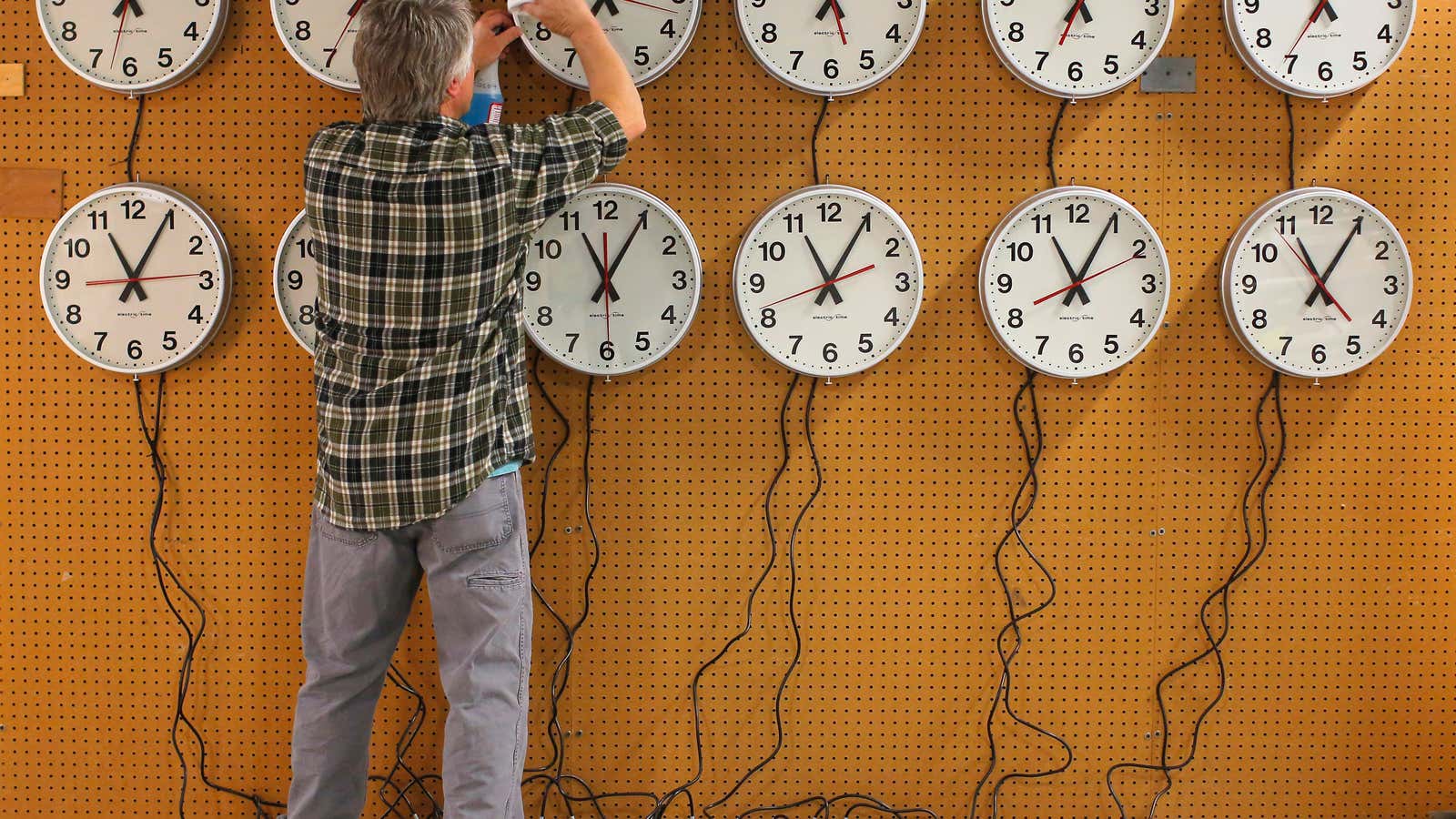Fall back, spring forward—for 1.6 billion people, that’s our biannual mantra as we once again change our clocks. Though daylight saving time was intended to help us better take advantage of daylight hours during the winter, in recent years evidence has begun to show that the time change causes more harm than good.
Lost productivity
In the spring, turning the clocks ahead causes some real damage. A 2009 study found that most Americans lose 40 minutes of sleep (pdf) in the spring when clocks change, which translates to lost productivity at work in the days that follow. By some estimates, that means a total of $434 million in losses nationally.
That gained hour of sleep in the fall comes with consequences, too: Some evidence suggests that, following the autumn time change, less daylight later in the day results in an 11% increase in depressive episodes, which also decreases productivity.
Health consequences
Lost sleep might not have real bodily consequences for white-collar workers, but that’s not the case for everyone. In that same analysis published in 2009, researchers looked at several decades’ worth of data and found a 5.7% increase in workplace injuries on the Monday following a springtime daylight saving time switch, resulting in 68% more work days lost. “We contend that the springtime change is associated with an increase in the number and severity of workplace accidents, especially for those engaged in jobs requiring a high level of attention to detail,” such as miners, the study’s authors told the Society for Human Resource Management. “Studies have shown that lost sleep causes attention levels to drop off.”
Time change is also connected to non-workplace health effects. Research published in 2016 found an 8% increase in the number of strokes in the two days following daylight saving time changes.
A 2014 study concluded that heart attacks were 25% more frequent on the Monday after the spring time change, but tapered off during the week, resulting in the overall same number of incidents as any other week. “It may mean that people who are already vulnerable to heart disease may be at greater risk right after sudden time changes,” Amneet Sandhu, a cardiology fellow at the University of Colorado in Denver and lead author, said in a press release.
Impaired judgment
The mental fog that sets in after a night of not enough sleep has diverse and surprising effects. Several studies have found a general uptick in traffic accidents during daylight saving time, as well as a 6% increase in fatal car crashes in the week after the spring clock change. Another analysis, from 2011, found a 2% decrease in SAT scores when the tests were taken after the time change. In a 2016 study, researchers determined that the sentences US judges gave defendants were 5% longer the Monday after the spring shift.
No effect on energy use
Reduced energy consumption was one of the key arguments in favor of daylight savings when it became federal law in 1966 (along with increased consumer spending). But the reality ended up being more complicated. One 2008 government analysis (pdf) found that daylight saving result in slight energy savings, while a separate 2008 study found that energy use actually increased.
Complicated time zone coordination
What’s the time difference between New York and Mumbai? Weirdly, it depends on the time of year, thanks to daylight saving time. Only 70 countries implement daylight saving time; changing the clocks doesn’t make much sense if you’re near the equator, where the amount of daylight doesn’t change as dramatically at different times of the year. Some daylight saving detractors have argued that the policy is Eurocentric and inhibits the collaboration of teams across countries and time zones. During an age of remote work, time zone differences can lead to missed or confused meeting times that last for weeks.

Is daylight saving time on its way out?
“There is no economic justification for DST,” my former colleague and economist Allison Schrager wrote in 2016.
Increasingly, the public seems to agree. Politicians in US states such as Washington, California, and Florida, as well as in the EU, have suggested making daylight saving time year-round, eliminating the time change. “The purpose of uniform time measures is coordination. How we measure time has always evolved with the needs of commerce,” Schrager wrote in 2013.
As logical as doing away with the time change may be, Schrager is skeptical that the anti-daylight saving contingent has enough willpower to push back against its proponents (mainly retail lobbies) to change something that’s already the law of the land. Only time will tell.
Correction: This article previously stated that the economic impact of daylight saving sleepiness was $434 billion, not million.
